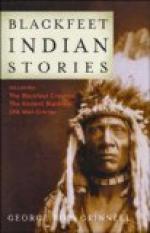These were the animals which the Blackfeet killed for food before the white men came, and of these the buffalo was the chief. Buffalo, more than any other animals, could be captured in numbers, and the Blackfeet, like the other Indians of the plains, had devised a method for taking them, so that when the buffalo were near the Blackfeet never suffered from hunger. Yet sometimes it happened that the buffalo went away, and that the lonely far travelling scouts sent out by the tribe could not find them. Then the people had to turn to the smaller animals—the elk, deer, antelope, and wild sheep.
In those old days, before they had horses, they did not make long marches when they moved. Their only domestic animal was the dog, which was used chiefly as a beast of burden, either carrying loads on its back or hauling a travois, formed by two long sticks crossing above the shoulders and dragging on the ground behind. Behind the dog these two sticks were united by a little platform, on which was lashed some small burden—sometimes a little baby.
In those days, when the people moved from one place to another, all who were large enough to walk and strong enough to carry a burden on the shoulders, were laden. Usually men, women, and children alike bore loads suited to their strength. Yet sometimes the men carried no loads at all, for if journeying through a country where they feared that some enemy might attack them, the men must be ready to fight and to defend their wives and children. A man cannot fight well if he is carrying a burden; he cannot use his arms readily, nor run about lightly—forward to attack, backward in retreat. If he is not free to fight well, his family will be in danger. White men who have seen Indians journeying in this way, and who have not understood why some women carried heavy loads and the men carried nothing, have said that Indian men were idle and lazy, and forced their women to do all the work. Those who wrote those things were mistaken in what they said. They did not understand what they saw. The truth is that these men were prepared for danger of attacks by enemies, and were ready to do their best to save their families from harm.
Carrying on their backs all their property, except the little which the dogs might pack, it is evident that the Indians in those days could not make long journeys.
In those days they had no buckets of wood or tin in which to carry water. Instead, they used a vessel like a bag or sack, made from the soft membrane of one of the stomachs of the buffalo. This, after it had been cleansed and all the openings from it save one had been tied up, the women filled at the stream with a spoon made of buffalo horn or with a larger ladle of the horn of the wild sheep. Because this water-skin was soft and flexible, it could not stand on the ground, and they hung it up, sometimes on the limb of a tree, more often on one of the poles of the lodge, or sometimes on a tripod—three sticks coming together at the top and standing spread out at the ground.




